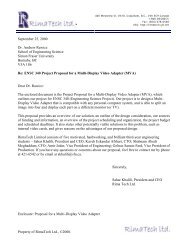Fleksibilni Internet servisi na bazi kontrole kašnjenja i
Fleksibilni Internet servisi na bazi kontrole kašnjenja i
Fleksibilni Internet servisi na bazi kontrole kašnjenja i
You also want an ePaper? Increase the reach of your titles
YUMPU automatically turns print PDFs into web optimized ePapers that Google loves.
[12]-[23] and loss rate differentiation [15], [24]-[27] among classes emerged recently.<br />
However, combined service differentiation across multiple QoS metrics is still an open<br />
issue because these mechanisms are not applicable to flows whose performance depends<br />
both on delay and loss rate, such as TCP flows. In case of TCP flows, delay and loss rate<br />
differentiations cannot be performed independently because their combined effect on<br />
TCP throughput might be unpredictable. Introduction of a low-delay service for delay-<br />
sensitive packets might increase the queuing delay and round-trip time for TCP packets<br />
that are used for bulk data transfer. Since the throughput of TCP flows depends on the<br />
round-trip time, delay differentiation might have negative effect on TCP applications.<br />
Since TCP traffic represents up to 95 % of the total traffic in today’s <strong>Internet</strong> [28],<br />
approaches that do not consider the interaction between service differentiation<br />
mechanism and TCP are not likely to be successful in practice.<br />
In this thesis, we propose a new non-elevated service differentiation architecture<br />
that provides delay and throughput differentiation between delay-sensitive and<br />
throughput-sensitive traffic classes. An <strong>Internet</strong> application may choose to mark its<br />
packets either as throughput-sensitive or delay-sensitive by setting a field in packets’ IP<br />
headers. Both classes benefit from the proposed architecture because delay-sensitive<br />
(real-time) applications receive low-delay service, while throughput-sensitive (TCP)<br />
applications are guarantied at least the same throughput as they would receive in a best-<br />
effort network. In addition to the new algorithm <strong>na</strong>med Packet Loss Controller (PLC)<br />
[30], the proposed architecture employs two existing router algorithms: a scheduling<br />
algorithm for proportio<strong>na</strong>l delay differentiation called Backlog-Proportio<strong>na</strong>l Rate (BPR)<br />
[12] and an active queue ma<strong>na</strong>gement (AQM) called Random Early Detection (RED)<br />
3






